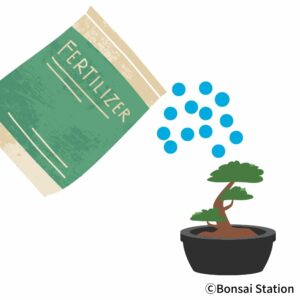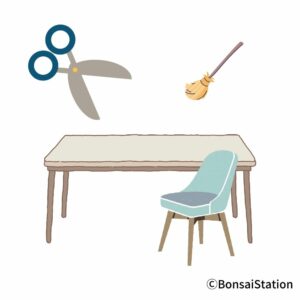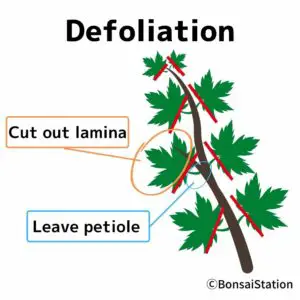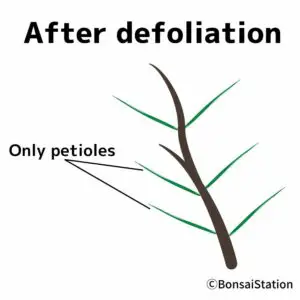How to defoliate bonsai
Before defoliating
Defoliation puts a lot of stress on bonsai trees. As such, they are to be well fertilized in advance in the previous year and/or early spring. If you defoliate weakened trees, new buds may not sprout or branches may wither. In the worst-case scenario, the entire trees may die off.
When to defoliate
The best time to defoliate bonsai trees is around May-June, when the trees’ regenerative power is at its strongest. Around that time, all the leaves that have sprouted in spring are open and trees are constantly storing energy through photosynthesis.
Defoliation should not be done after summer began. Trees’ regeneration slows down when the weather is getting hot.
Tools you need to defoliate
To defoliate a bonsai tree, you need;
- Table (and chair),
- One (or two) pair(s) of scissors/sheers and
- Small broom.
Table
Prepare a tale where you can put bonsai tree(s) to monitor them well. Defoliating a bonsai tree requires quite a lot of time and observation. You have to inspect the tree thoroughly and see if the branches are doing OK, and decide whether to defoliate totally or partially. Then, you have to cut a considerable number of leaves very carefully one by one.
Chair
If you are defoliating more than one tree, sitting on a chair might be a good idea. It will take at least a full day to defoliate several full-sized bonsai trees.
Scissors/sheers
When defoliating several bonsai trees or smaller trees, it is good to prepare two pairs of scissors/sheers, normal ones and lighter/smaller ones. Switching to lighter/smaller ones helps you not hurt your wrists and fingers.
Small broom
You can use a small broom to sweep out leaves that you cut out from the branches.
How to defoliate
There are two major types of bonsai defoliation: total and partial defoliation of all the leaves of a tree. There is also defoliation of cutting only large leaves, leaving others intact.
How defoliation works
Defoliation is a bonsai technique to stimulate the sprouting of new buds at the base of the petiole to produce smaller leaves by cutting off all or part of the leaves when the leaves have grown too large off balance with your bonsai tree.
After defoliation, bonsai trees grow smaller leaves and branches with short nodes as tree vigor is suppressed. The size of the leaves becomes smaller if you repeat the process more than once in the season.
Step-by-step instruction to defoliate
Total defoliation
- Observe and check the bonsai tree(s) well to see if they can be defoliated. Select the ones that are vigorous and healthy. If they look weak, sick, infested by insects, or their leaves are not fully open yet, do not defoliate at all.
- Place the pot on the table. Cut out lamina (leaf blades), leaving only the petioles one by one using scissors/sheers. Start from the top of the tree, and gradually move down.
- Use a small broom to sweep the leaves that are cut from the tree.
Partial defoliation
If you find thin branches that you want to thicken, leave those branches without defoliating. For branches that are not growing well, cut only part of the leaves and leave the other part to encourage the growth of those branches.
Depending on the tree vigor, you can freely adjust the amount of leaf cutting; cutting half, 1/4 or not at all.
Defoliating only the large leaves
The key to defoliation is to make all leaves smaller with approximately the same size. When you look at your bonsai trees, you may notice leaves on some branches are smaller and others are larger. In such a case, cut only larger leaves. Sunlight and fresh air enter the inside of the tree, activating other new leaves to sprout as well.
Defoliating by hands
For trees like zelkova, which have numerous leaves, you can carefully rip them off by hand. It will be extremely painstaking, requiring lots of time and effort, to cut off each leaf using scissors one by one.
Cautions when defoliating
- Check the weather forecast and pick a date when sunny days last for about a week after defoliation.
- Do not fully defoliate weak branches or branches that you want to grow or thicken. Weaker branches may not tolerate defoliation. Keep the leaves untouched, cut half/quarter or cut out some of them, leaving others.
- Do not defoliate trees that have just been repotted or on trees that you want to grow the whole trees.
- Do not defoliate trees whose root system is not fully developed.
- Do not defoliate trees more than once a season if they are not strong enough.
- Do fertilize well before defoliation to make the tree more robust and healthier. Make sure to choose the trees that are growing vigorously.
Defoliation aftercare
After defoliation, bonsai trees should be watered thoroughly and must immediately be placed on a shelf outdoors and exposed to sufficient sunlight until they sprout.
If the sunlight is too strong in your region, do not expose them to direct sunlight. Put a sheer cloth or shading net to protect them from direct sunlight. When new leaves begin to open, gradually acclimate to the sun and switch to normal management.
Do not let the water run out, but be careful not to overwater them as well, as bonsai trees without leaves do not need as much water. A normal watering schedule might cause root rot. If you can, use well-drained soil so that water can easily drain through the bottom of the pot.
If the weather is not too warm and dry, mist the branches 2-3 times a day to encourage sprouting instead of watering. It is better not to expose them to rain until new shoots appear.
New buds will sprout in about 1-2 weeks. Never fertilize until new leaves have fully opened.








